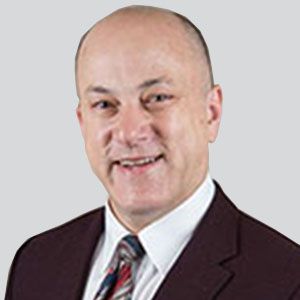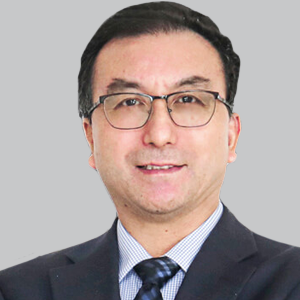Article
Satralizumab's Efficacy in NMOSD Boosts the Case for IL-6 Inhibition
Author(s):
Study coauthor and professor of neurology and ophthalmology at the University of Colorado provides insight into phase 3 study results of satralizumab, presented at ECTRIMS 2019.

Jeffrey Bennett, MD, PhD
Phase 3 data from the SAkuraStar study (NCT02073279) of satralizumab for the treatment of neuromyelitis optica spectrum disorder (NMOSD) demonstrate a significantly reduced risk for relapse, though notably, patients who were seronegative for aquaporin-4 (AQP4) autoantibodies did not show as great of a degree of response as the seropositive cohort.
Presented at ECTRIMS 2019, September 11-13 in Stockholm, Sweden, the findings support the efficacy and safety of the humanized monoclonal antibody monotherapy in patients in the general NMO population and those who are seropositive or seronegative for AQP4 autoantibodies. Results showed a 55% reduction of relapse risk in patients treated with satralizumab monotherapy compared with placebo (hazard ratio [HR] 0.45; 95% CI, 0.23-0.89; P =.018). In total, 30.2% of patients in the treatment group experienced a relapse compared with 50% of patients in the placebo group.
To learn more about the investigational therapy and what the latest data could mean for clinical practice, NeurologyLive spoke with Jeffery Bennett, MD, PhD, study coauthor and professor of neurology and ophthalmology, University of Colorado.
NeurologyLive: What were some of the key findings from the satralizumab study?
Jeffery Bennett, MD, PhD: The results of the study were that satralizumab, used as a monotherapy in the treatment of patients with neuromyelitis optica (NMO) and neuromyelitis optica spectrum disorder (NMOSD), showed significant efficacy in the reduction of time to relapse in disease, which was the primary outcome of this study. It showed a similar robust effect in certain subgroups as divided by diagnostic criteria—that is, whether they had NMOSD seropositive disease or NMOSD seronegative disease, whether they had prior immunosuppressant therapy, and whether they were diagnosed after prior relapse.
In addition, it has a great tolerability profile in adverse events, infections, there were no deaths in the trial or any reaction to the injection medication. It showed broad tolerability, and now, as the second trial of satralizumab in this condition—the first trial being an add-on trial to ongoing immunosuppression—it has shown efficacy for relapse reduction in a broad variety of patient situations.
While the agent is still investigational, what do the findings potentially mean for real-life use in clinic?
Well, from the broad group of patients that were enrolled, which included all patients meeting clinical criteria for NMO, whether they were seropositive for APQ4 IgG, or seronegative, and for the entire patient cohort, satralizumab showed efficacy as monotherapy, particularly showing efficacy in the APQ4 seropositive subgroup.
There was no similar efficacy observed in the seronegative cohort, possibly because the study was underpowered, and possibly because what we consider currently seronegative NMO is a different condition than what seropositive patients have. And, we already know from background studies in the field that many patients who have MOG-IgG disease may mimic NMO, and we currently don't know how many of those patients might have been enrolled in in this study under the seronegative categories.
With regard to other issues, I think what neurologists treating in practice can really take home is that there's now been 2 separate studies with interleukin 6 (IL-6) receptor inhibition and both have been quite successful in reaching their primary outcome, which in this disease is the elimination of relapse. Relapses, being potentially debilitating or devastating in this disease and the source of progressive neurologic dysfunction or disability, is a primary outcome that we want to see in our NMO patients. On a scientific level, it shows that IL-6 is a key driver of immune pathology and NMO is justified on a clinical level, and it gives us the opportunity to consider patients who are on prior therapy as well as off prior therapy that the addition of this agent is going to have efficacy. If they decide to switch therapies, this leads to a broader comfort level in both situations. The adverse event profile was quite low, and it gives clinicians the option of feeling that if the patient was getting some benefit from the prior therapy, they can get additional benefit from adding on this medication, or if they felt they had little to be gained or had significant side effects from their prior therapy, they could switch and feel comfortable with monotherapy.
Is further study of satralizumab planned?
There is an ongoing open-label study with patients from the SAkuraStar study who were enrolled at the conclusion of the study, or at the time they had an adjudicated relapse, and that is ongoing for further safety data. Long-term safety data is necessary for physicians to feel comfortable with this avenue of targeted IL-6 receptor inhibition, although it has been used for several years with tocilizumab in the rheumatologic field.
Also, obviously once this agent goes through regulatory approval, regulators will likely want further safety data, and what they demand in terms of continuing safety data we can only wait to hear about. So in terms of subgroups, it will be interesting to see what we learn about the nature of the patients who were seronegative in this trial, whether there's a good reason to think that they had something distinct from NMO—i.e, MOG IgG disease or whether they are what we currently call double seronegative patients—will help us as clinicians try to understand whether these patients are worth further study. That is, that most of them were something we may not have a clue on that looks like NMO and we want to know how good IL-6 receptor signaling modulation works in those conditions, or whether they are more likely something distinct and we know better than to potentially use this approach in what may be a different disease state that's mimicking NMO.
We understand now after years of mistakenly considering that NMO itself was a variant of MS, that as clinicians we often can confuse autoimmune disorders of the nervous system that look like each other. The fact is, moving forward to the field of NMO therapeutics, we’re not immune to making that mistake at different levels as we try to classify disorders going forward, and that's one of the reasons that clinical trials were necessary in this condition. That is, to make sure that our current understanding, or thoughts, of what is driving pathophysiology in this condition were correct and to avoid the mistake and adoption of therapeutics into this condition that may worsen the disease or be ineffective—as we've learned from prematurely adopting MS therapeutics in the NMO field.
Were any of the findings or datasets surprising or unexpected in any way?
There was nothing unexpected in the results, looking from the perspective of having the SAkuraSky study results come out. That is, you had already seen from that trial that in the background of concurrent immunosuppression that there was a statistically significant reduction in risk of relapse across the study cohort and that it was significantly borne out in those patients that were AQP4 seropositive. To see that mirrored in this monotherapy trial, it was not a surprise that it was well tolerated at the time of this SAkuraStar study.
Perhaps, there were a surprising lack of injection-related adverse effects. As we've come to understand in the MS field, injectables often have a significant adverse event profile, so the fact that it lacks signature of infection risk was a pleasant surprise. Those were borne out in this study as well, suggesting that, from the point of having an immunosuppressant on board when you're getting injections, the adverse rates for injections wasn't due to the fact that you were knocking down the immune system with a concurrent immunosuppressant.
Overall, no big surprises here, and the consistency of the 2 trials is rather encouraging. As a clinician and also as a clinical investigator, when you get things across populations repeating themselves, you know that the effect that's attributable to your agent is only being reinforced.
For more coverage of ECTRIMS 2019, click here.
REFERENCE
Traboulsee A, Greenberg B, Bennett JL, et al. Efficacy and safety of satralizumab monotherapy for relapse prevention in neuromyelitis optica spectrum disorder (NMOSD): results from SAkuraStar, a double-blind placebo-controlled Phase 3 clinical study. Presented at: ECTRIMS 2019. September 11-13, 2019; Stockholm, Sweden. Abstract P603.




